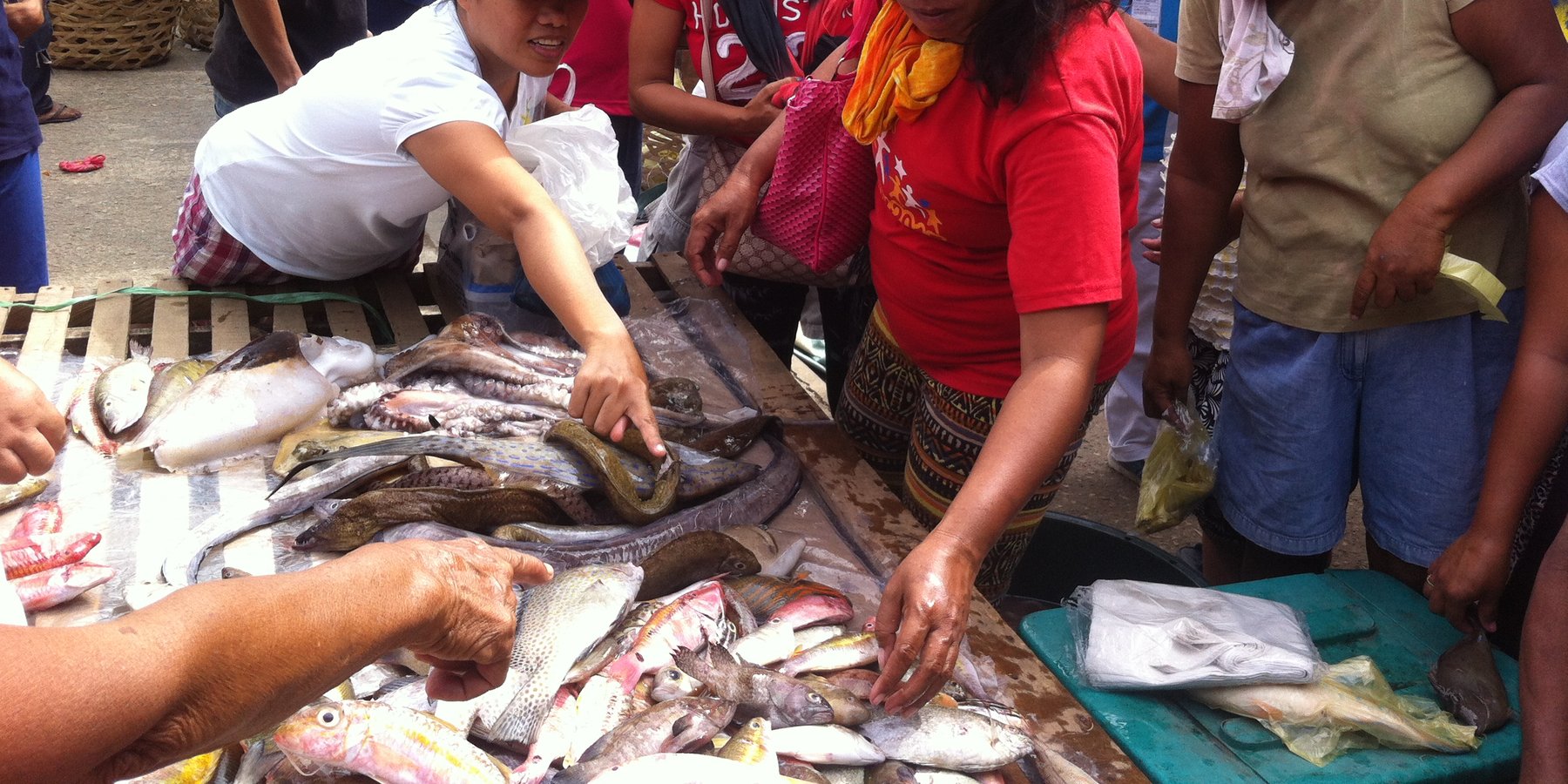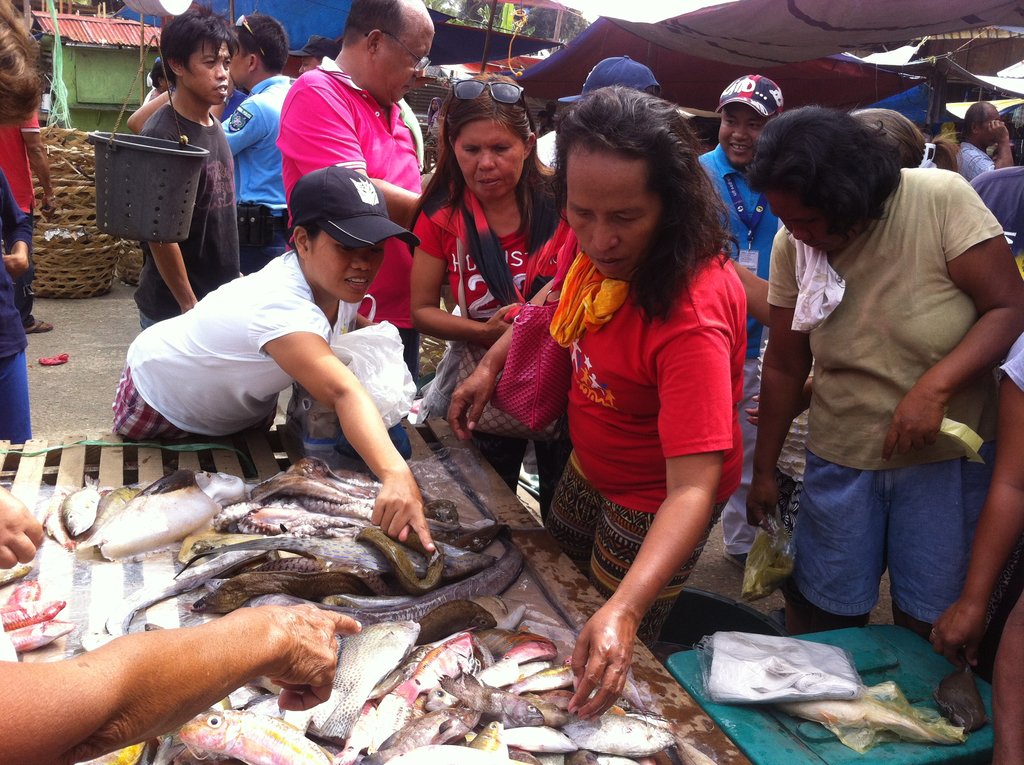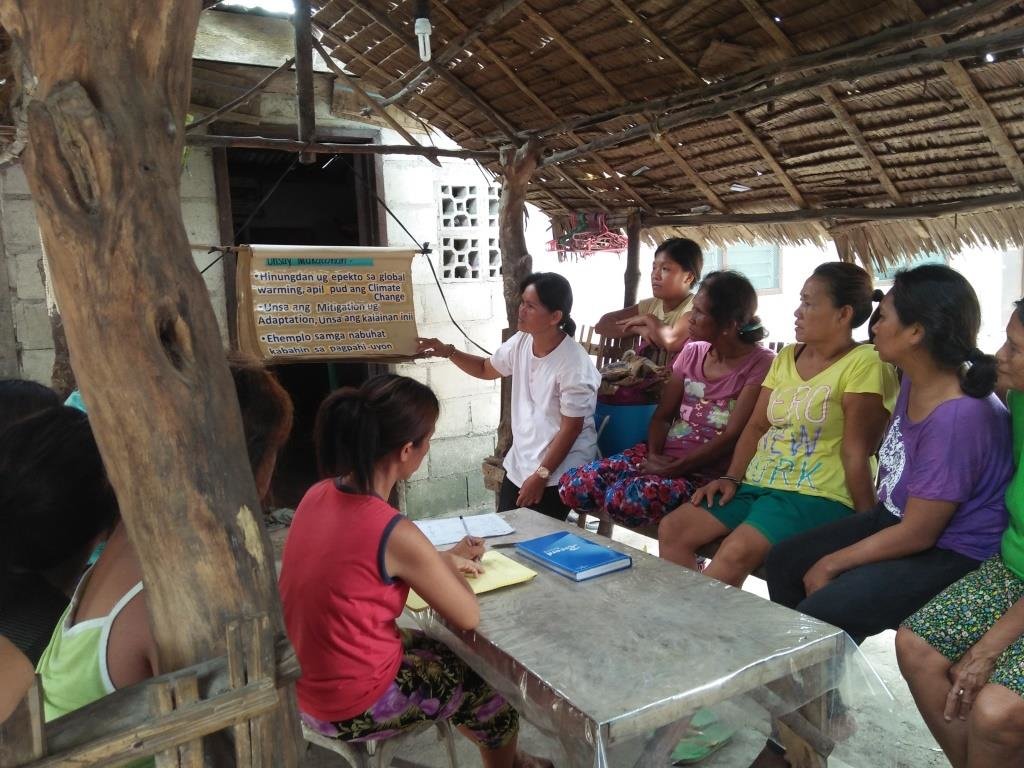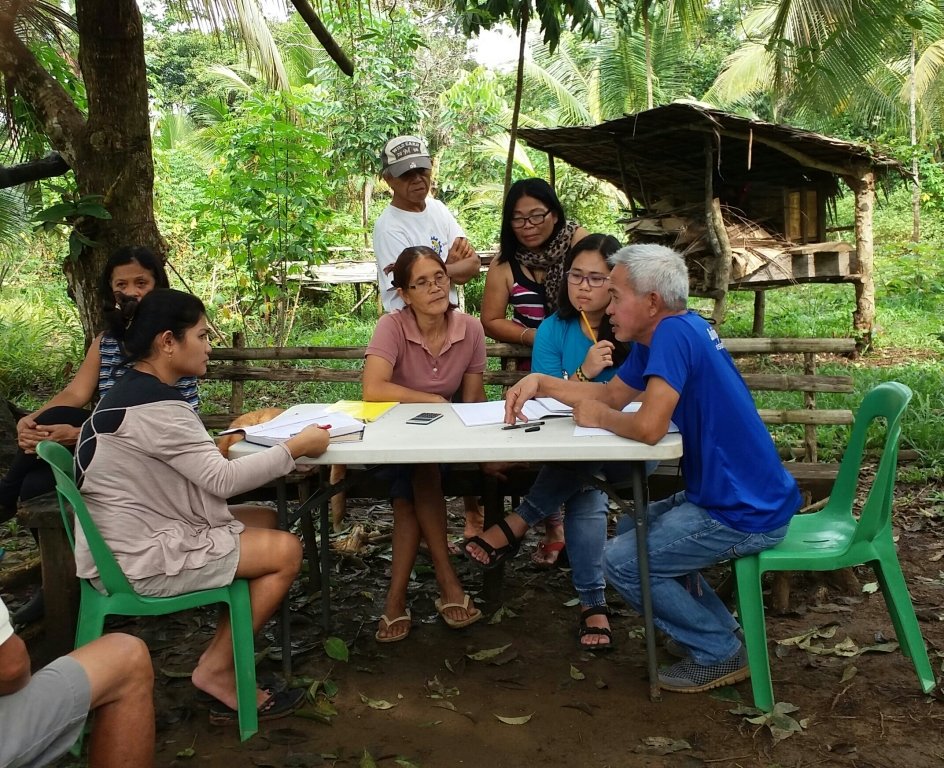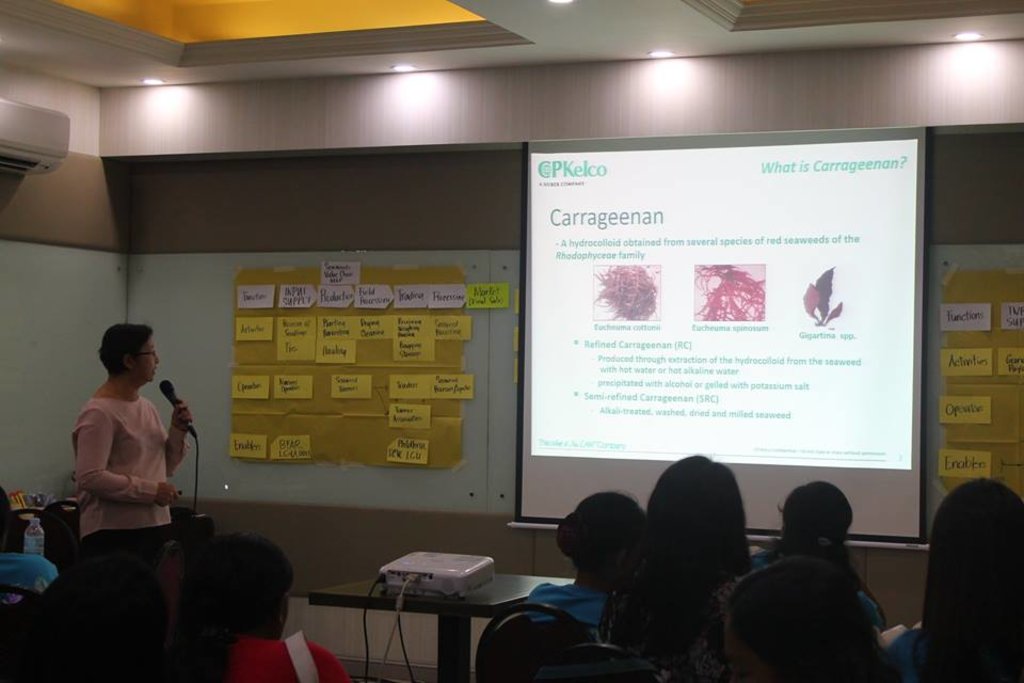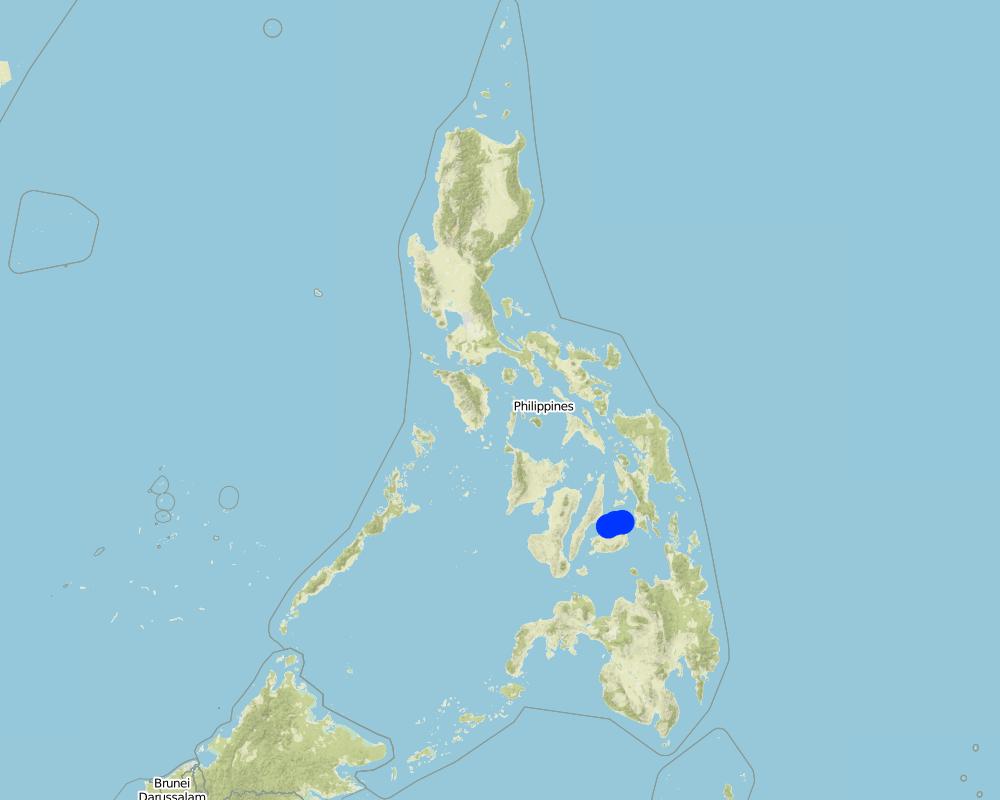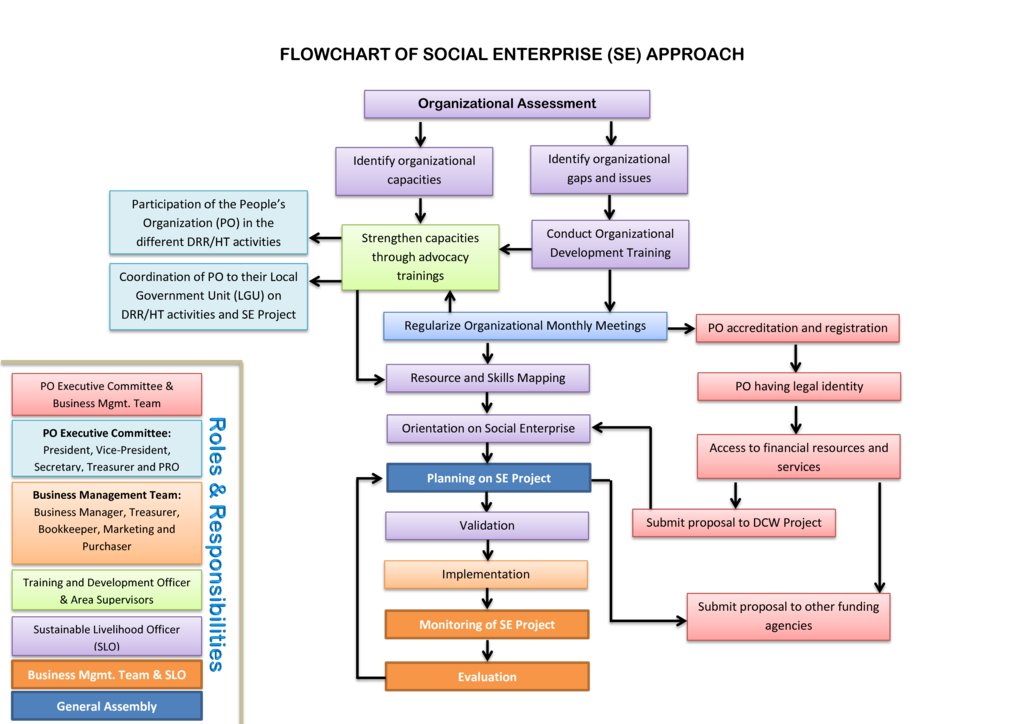Social Enterprise (SE) [ប្រទេសហ្វីលីពីន]
- ការបង្កើត៖
- បច្ចុប្បន្នភាព
- អ្នកចងក្រង៖ Keeshia Lynn Marie Austria
- អ្នកកែសម្រួល៖ –
- អ្នកត្រួតពិនិត្យ Alexandra Gavilano
Katilingbanong Patigayon
approaches_3119 - ប្រទេសហ្វីលីពីន
ពិនិត្យមើលគ្រប់ផ្នែក
ពង្រីកមើលទាំងអស់ បង្រួមទាំងអស់1. ព័ត៌មានទូទៅ
1.2 ព័ត៌មានលម្អិតពីបុគ្គលសំខាន់ៗ និងស្ថាប័នដែលចូលរួមក្នុងការវាយតម្លៃ និងចងក្រងឯកសារនៃវិធីសាស្ត្រផ្សព្វផ្សាយ
បុគ្គលសំខាន់ម្នាក់ (ច្រើននាក់)
Sustainable Livelihood Officer (SLO):
ប្រទេសហ្វីលីពីន
ឈ្មោះគម្រោងដែលបានចងក្រងឯកសារ/ វាយតម្លៃលើវិធីសាស្ត្រផ្សព្វផ្សាយ (បើទាក់ទង)
Danajon Communities WATCH ( DCW)ឈ្មោះអង្គភាពមួយ (ច្រើន) ដែលបានចងក្រងឯកសារ/ វាយតម្លៃលើវិធីសាស្ត្រផ្សព្វផ្សាយ (បើទាក់ទង)
Philippine Partnership for the Development of Human Resoruces in Rural Areasy (PhilDHRRA) - ប្រទេសហ្វីលីពីន1.3 លក្ខខណ្ឌទាក់ទងទៅនឹងការប្រើប្រាស់ទិន្នន័យដែលបានចងក្រងតាមរយៈវ៉ូខេត
តើពេលណាដែលទិន្នន័យបានចងក្រង (នៅទីវាល)?
04/04/2017
អ្នកចងក្រង និង(បុគ្គលសំខាន់ៗ)យល់ព្រមទទួលយកនូវលក្ខខណ្ឌនានាទាក់ទងទៅនឹងការប្រើប្រាស់ទិន្នន័យដែលបានចងក្រងតាមរយៈ វ៉ូខេត:
បាទ/ចា៎
1.4 ការយោងមួយ (ច្រើន) ទៅលើ (កម្រង) បញ្ជីសំណួរនៃបច្ចេកទេស SLM
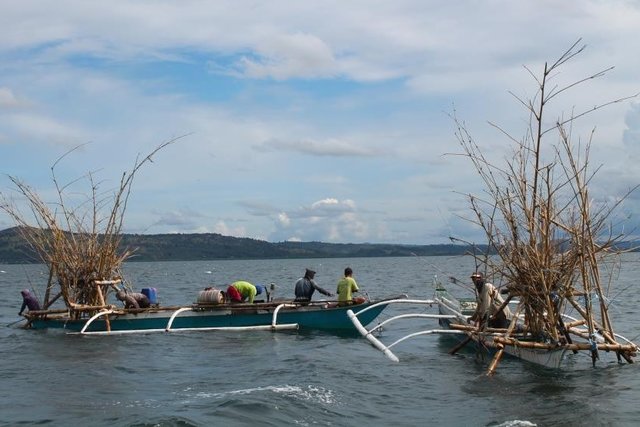
Artificial Reef [ប្រទេសហ្វីលីពីន]
Artificial Reef is a fish aggregating device that is considered as a sustainable alternative in the islands of Bohol. This technology can withstand the effects of gale warning, typhoons and extreme heat.
- អ្នកចងក្រង៖ Keeshia Lynn Marie Austria
2. ការពណ៌នាអំពីវិធីសាស្ត្រផ្សព្វផ្សាយ SLM
2.1 ពណ៌នាសង្ខេបខ្លីពីវិធីសាស្ត្រផ្សព្វផ្សាយ
Social Enterprise (SE) aimed to provide social protection among its members and generate additional family income. Above all, this approach will encourage the conservation, preservation and protection of the resources available in the community.
2.2 ពណ៌នាលម្អិតពិវិធីសាស្ត្រផ្សព្វផ្សាយ
ពណ៌នាលម្អិតពិវិធីសាស្ត្រផ្សព្វផ្សាយ:
Social Enterprise (SE) materialized because of the experiential processes conducted by the Sustainable Livelihood Officer. According to him, livelihood intervention should achieve the advocacy of the project, at the same time, relevant and suitable to the people living in the island and coastal communities. SE Approach was a result of the focus group discussions conducted in the community and livelihood consultations of the different stakeholders in the barangay level. According to the Local Government Code of the Philippines, Book III, Section 386 (a), A Barangay maybe created out of a contiguous territory which has a population of at least two thousand (2,000) inhabitants as certified by the National Statistics Office. Furthermore, Section 386 states that barangay is the basic political unit. It serves as the primary planning and implementing unit of government policies, plans, programs, projects, and
activities in the community, and as a forum wherein the collective views of the people may be expressed, crystallized and considered, and where disputes may be amicably settled.
Social Enterprise Project was determined using the following methods: resource mapping, identification of social enterprise project, planning and preparation which includes community equity fund, implementation, maintenance and monitoring, lastly, expansion and/or diversification of the implemented project. Once the enterprise is established, the organization will elect the members of their business management team. This is different from the set of officers typically present in every organization because business management team will focus on the business engagements only. The business management team is headed by the business manger, who will report directly to the president of the organization. The members of the team includes the following: treasurer, bookkeeper, purchaser and marketing team (if needed by the enterprise project).
The management team will receive 20% of the net income. Afterwards, the remaining net income will be divided according to the following percentage: 10% for disaster fund allocation, 10-20% for additional capital, and the remaining amount is allocated for individual member share. SE does not only focus on net profit but also the welfare of the community, its resources and social protection among its members. Social protection specifically means having disaster fund allocation per organization which is derived from the net income of the enterprise. This fund can be utilized by the organization before or after the onset of a disaster, depending on their agreed utilization guidelines. The sustainability components are the following: allocation for additional capital, depreciation cost for every equipment and experiential mentoring of the Livelihood Officer.
Based from the baseline study of DCW Project, Human Trafficking cases increased after a disaster. DCW project aimed to build resilient communities in order to combat Human Trafficking, however, conducting awareness sessions, coordination meetings with the local government unit and establishing HT referral system is not enough to prevent Human Trafficking. On the second year of the project, the project management team realized that livelihood component is the missing link in fighting against Human Trafficking. The body agreed that sustainable livelihood project means being adaptable and resilient to climate change. For the livelihood officer, group enterprise is an important mechanism in promoting adaptable and resilient livelihood project. This approach was granted to the People's Organization (PO) in the barangays who were organized or adopted by DCW project.
Due to the awareness sessions conducted, the organizations were motivated to join the advocacy activities like coastal clean-up and mangrove planting. They were also invited to join forums on the Solid Waste Management (SWM), referral pathway on Human Trafficking (HT) and awareness training on the causes and effects of Climate Change and sea level rise, since they are living in the island and coastal barangays. PO organizations serve as community partners of DCW project in facilitating learning sessions in the different barangays. Furthermore, DCW project provided inputs how to make their enterprise resilient and sustainable by being adaptive to the changing weather especially those organizations living in the island barangays.
2.3 រូបភាពនៃវិធីសាស្ត្រផ្សព្វផ្សាយ
2.5 ប្រទេស/តំបន់/ទីតាំងកន្លែង ដែលវិធីសាស្ត្រផ្សព្វផ្សាយត្រូវបានអនុវត្តន៍
ប្រទេស:
ប្រទេសហ្វីលីពីន
តំបន់/រដ្ឋ/ខេត្ត:
Province of Bohol
Map
×2.6 កាលបរិច្ឆេទនៃការចាប់ផ្តើម និងបញ្ចប់នៃវិធីសាស្រ្តផ្សព្វផ្សាយនេះ
សូមបញ្ជាក់ឆ្នាំដែលបានបង្កើតឡើង:
2016
ប្រសិនអត់ចាំឆ្នាំ សូមចង្អុលបង្ហាញកាលបរិច្ឆេទប្រហែលៗពេលដែលវិធីសាស្ត្រផ្សព្វផ្សាយត្រូវបានចាប់ផ្តើមប្រើ:
តិចជាង 10ឆ្នាំមុន (ថ្មី)
មតិយោបល់:
The Social Enterprise project of the different organizations are currently ongoing.
2.7 ប្រភេទនៃវិធីសាស្ត្រផ្សព្វផ្សាយ
- ផ្អែកលើគម្រោង/កម្មវិធី
2.8 គោលបំណង/ទិសដៅសំខាន់នៃវិធីសាស្ត្រផ្សព្វផ្សាយ
Social Enterprise (SE) aimed to provide social protection among its members and generate additional family income. Above all, this approach will encourage the conservation, preservation and protection of the resources available in the community.
2.9 លក្ខខណ្ឌអនុញ្ញាត ឬរារាំងការអនុវត្តន៍បច្ចេកទេសដែលស្ថិតនៅក្រោមវិធីសាស្រ្តផ្សព្វផ្សាយ
សង្គម/វប្បធម៌/ និងតម្លៃនៃសាសនា
- អំណោយផល
Membership of the organization encouraged multi stakeholder participation.
ភាពអាចរកបាននៃធនធានហិរញ្ញវត្ថុ និងសេវាកម្ម
- អំណោយផល
The People's Organization (PO) can easily access financial resources and services if they were already established and registered by the different government agencies. One of the determinants of the capability of the PO is having annual financial statement, minutes of the organizational meetings and resolutions made by the organization.
- រារាំង
Having a weak or inactive People's Organization. If the PO does not comply the necessary requirements of the different government agencies and inactive in the different organizational activities, then, they will have difficulty in accessing funds.
បរិបទនៃស្ថាប័ន
- អំណោយផល
It will facilitate to address the needs of the organization like capacity building, technical assistance and financial support.
- រារាំង
The bureaucratic procedures and priorities of every institution.
ការសហការ/ការសម្របសម្រួលតួអង្គពាក់ព័ន្ធ
- អំណោយផល
It will make the decision-making process participatory and according to the needs of the majority.
ក្របខណ្ឌច្បាប់ (សិទ្ធិកាន់កាប់ដីធ្លី កម្មសិទ្ធីប្រើប្រាស់ដីនិងទឹក)
- អំណោយផល
This approach specifically refers to Coastal Resource Management (CRM). The project implementer, People's Organization (PO) and the CRM officer already had partnership. Moreover, the PO representative is one of the members of CRM council to ensure legal identity of the Social Enterprise projects.
គោលនយោបាយ
- អំណោយផល
It will give directions and set the standards of the organization.
- រារាំង
If the policies mandated were not agreed by the majority.
ទីផ្សារ (ទិញធាតុចូល លក់ផលិតផល) និងតម្លៃ
- អំណោយផល
The People's Organization (PO) already established linkage to the different markets.
- រារាំង
The quality of product expected by the buyers is not met by the People's Organization.
ទំហំការងារ ភាពអាចរកបាននៃកម្លាំងពលកម្ម
- អំណោយផល
DCW Project provided Social Enterprise (SE) guidelines for business operation, financial management and monitoring of enterprise.
3. ការចូលរួម និងតួនាទីរបស់ភាគីពាក់ព័ន្ធ
3.1 អ្នកពាក់ព័ន្ធដែលបានចូលរួមក្នុងវិធីសាស្ត្រផ្សព្វផ្សាយ និងតួនាទីរបស់ពួកគេ
- អង្គការសហគមន៍មូលដ្ឋាន
People's Organization
The implementer and beneficiary of the project.
- អ្នកឯកទេសគ្រប់គ្រងដីប្រកបដោយចីរភាព/ទីប្រឹក្សាបច្ចេកទេសកសិកម្ម
Sustainable Livelihood Officer: Male, 59 years old
Facilitates the implementation of the SE projects and provides technical assistance to the PO and project staff.
- រដ្ឋាភិបាលថ្នាក់មូលដ្ឋាន
Municipal and barangay local government unit
Support system through legislation and resolution that adheres the needs of the PO.
3.2 ការចូលរួមរបស់អ្នកប្រើប្រាស់ដីក្នុងតំបន់/ សហគមន៍ក្នុងតំបន់ក្នុងដំណាក់កាលផ្សេងគ្នានៃវិធីសាស្រ្តផ្សព្វផ្សាយ
| ការចូលរួមរបស់អ្នកប្រើប្រាស់ដីក្នុងតំបន់/សហគមន៍ក្នុងតំបន់ | សូមបញ្ជាក់នរណាត្រូវបានចូលរួម ព្រមទាំងពណ៌នាសកម្មភាពទាំងនោះ | |
|---|---|---|
| ការចាប់ផ្តើម/ការលើកទឹកចិត្ត | អន្តរកម្ម | PO members, Sustainable Livelihood Officer, Field Officers, Area Supervisors and representative of the barangay council. Activity: FGD, resource mapping, consultations and assessment of the organizations capability in handling social enterprise project. |
| ការរៀបចំផែនការ | អន្តរកម្ម | PO members, Sustainable Livelihood Officer, Field Officers, Area Supervisors and representative of the barangay council |
| ការអនុវត្តន៍ | គំនិតផ្តួចផ្តើមដោយខ្ឡួនឯង | PO members, Sustainable Livelihood Officer, Field Officers and Area Supervisors |
| ការត្រួតពិនិត្យ និងវាយតម្លៃ | គំនិតផ្តួចផ្តើមដោយខ្ឡួនឯង | PO members, Sustainable Livelihood Officer and Field Officers |
3.3 គំនូសបំព្រួញ (ប្រសិនបើមាន)
ការពណ៌នា:
Capacity building on Disaster Risk Reduction (DRR) and Human Trafficking (HT) is integrated in this approach so that PO members will have greater appreciation on the preservation, conservation and protection goal of SE approach. The Sustainable Livelihood Officer (SLO) served as facilitator and guide of the PO in strengthening their organization and implementing their enterprise. He will also provide technical assistance, conduct coaching and mentoring sessions within the project term. Frequency of monitoring will depend on the nature of their SE project.
អ្នកនិពន្ធ:
Guillermo P. Bagacay
3.4 ការសម្រេចចិត្តលើការជ្រើសរើសបច្ចេកទេស SLM
សូមបញ្ជាក់តើអ្នកណាជាអ្នកបានសម្រេចចិត្តក្នុងការជ្រើសរើសបច្ចេកទេសដើម្បីយកមកអនុវត្តន៍:
- គ្រប់ភាគីពាក់ព័ន្ធទាំងអស់ដែលជាផ្នែកនៃវិធីសាស្រ្តផ្សព្វផ្សាយដោយមានការចូលរួម
ចូរពន្យល់:
Focus Group Discussion (FGD) and livelihood consultations in the barangay level were conducted by the livelihood officer in order to achieve a feasible and suitable Social Enterprise project specific for their community. After leveling off and the exchange of ideas based from their previous experience vis-a-vi the current trend of the weather patterns and climate change, the organization finally arrived to a conclusion and implement their desired social enterprise project.
សូមបញ្ជាក់ តើការសម្រេចធ្វើឡើងដោយផ្អែកលើអ្វីជាមូលដ្ឋាន:
- បទពិសោធន៍ និងគំនិតផ្ទាល់ខ្លួន(ពុំមានចងក្រងជាឯកសារ)
4. ជំនួយបច្ចេកទេស ការកសាងសមត្ថភាព និងការគ្រប់គ្រងចំណេះដឹង
4.1 ការកសាងសមត្ថភាព/ បណ្តុះបណ្តាល
តើវគ្គបណ្តុះបណ្តាលបានផ្តល់ឱ្យអ្នកប្រើប្រាស់ដី/អ្នកពាក់ព័ន្ធផ្សេងៗទៀតដែរឬទេ?
បាទ/ចា៎
សូមបញ្ជាក់តើអ្នកណាត្រូវបានបណ្តុះបណ្តាល:
- អ្នកប្រើប្រាស់ដី
ទម្រង់នៃការបណ្តុះបណ្តាល:
- ទីតាំងបង្ហាញ
ទម្រង់នៃការបណ្តុះបណ្តាល:
- On-site coaching and mentoring
ប្រធានបទបណ្តុះបណ្តាល:
1) Technical Assistance in drafting proposals and lobbying
2) Financial Recording and Bookkeeping
3) Value Chain Analysis
4) Enterprise Development
5) Occupational Health and Health Standards
4.2 សេវាផ្តល់ប្រឹក្សាយោបល់
តើអ្នកប្រើប្រាស់ដីបានទទួលនូវសេវាផ្តល់ប្រឹក្សាដែរ ឬទេ?
បាទ/ចា៎
សូមបញ្ជាក់ប្រសិនបើសេវាកម្មប្រឹក្សាយោបល់ត្រូវបានផ្តល់ឱ្យ:
- នៅលើដីរបស់អ្នកប្រើប្រាស់ដី
4.3 ការពង្រឹងសមត្ថភាពស្ថាប័ន (ការអភិរឌ្ឍន៍អង្គភាព)
តើស្ថាប័នទាំងអស់ត្រូវបានបង្កើតឡើង ឬពង្រឹងសមត្ថភាពតាមរយៈវិធីសាស្ត្រផ្សព្វផ្សាយដែរ ឬទេ?
- បាទ/ច៎ា ជាមធ្យម
សូមបញ្ជាក់ថាតើស្ថាប័នត្រូវបានពង្រឹង ឬបង្កើតឡើងនៅត្រឹមកម្រិតណា(ច្រើន)?
- ថ្នាក់មូលដ្ឋាន
ចូពណ៌នាពីស្ថាប័ន តួនាទី និងទំនួលខុសត្រូវ សមាជិក ។ល។:
Some of the members of the organization are capacitated to become local champions. Local champions means they have the ability to facilitate learning sessions, actively involved in organizational activities and empowered enough to link and lobby with the different line agencies. While the leaders of the organization are trained to manage their organizations and social enterprise.
សូមបញ្ជាក់ប្រភេទនៃការគាំទ្រ:
- ហិរញ្ញវត្ថុ
- ការកសាងសមត្ថភាព/ បណ្តុះបណ្តាល
- Seed Capital worth Php30,000
4.4 ការត្រួតពិនិត្យ និងវាយតម្លៃ
តើការត្រួតពិនិត្យ និងវាយតម្លៃគឺជាផ្នែកមួយនៃវិធីសាស្ត្រដែរឬទេ?
បាទ/ចា៎
ប្រសិន បាទ/ច៎ា តើឯកសារនេះបានបង្កើតឡើងក្នុងគោលបំណងប្រើប្រាស់សម្រាប់ការត្រួតពិនិត្យ និងវាយតម្លៃដែរឬទេ?
ទេ
4.5 ការស្រាវជ្រាវ
តើការស្រាវជ្រាវ គឺជាផ្នែកមួយនៃវិធីសាស្រ្តដែរឬទេ?
ទេ
5. ថវិកា និងសម្ភារៈឧបត្ថម្ភពីខាងក្រៅ
5.1 ថវិកាប្រចាំឆ្នាំសម្រាប់ផ្សព្វផ្សាយ SLM
ប្រសិនបើចំនួនពិតប្រាកដនៃថវិកាប្រចាំឆ្នាំមិនត្រូវបានដឹងច្បាស់ សូមប្រាប់ពីចន្លោះនៃថវិកានោះ:
- 2,000-10,000
មតិយោបល់ (ឧ. ប្រភពសំខាន់នៃមូលនិធិ/ម្ចាស់ជំនួយចំបង):
DCW Project is funded by Caritas Switzerland and JTIF
5.2 ការគាំទ្រផ្នែកហិរញ្ញវត្ថុ / សម្ភារៈដែលបានផ្តល់ទៅឱ្យអ្នកប្រើប្រាស់ដី
តើអ្នកប្រើប្រាស់ដីបានទទួលការគាំទ្រផ្នែកហិរញ្ញវត្ថ/សម្ភារៈសម្រាប់ការអនុវត្តន៍បច្ចេកទេសដែរឬទេ:
ទេ
5.3 សូមបញ្ជាក់ពីធាតុចូលត្រូវបានផ្តល់បដិភាគ (រួមទាំងកម្លាំងពលកម្ម)
- គ្មាន
ប្រសិនបើកម្លាំងពលកម្មធ្វើដោយអ្នកប្រើប្រាស់ដី តើវាជាធាតុចូលដ៏សំខាន់មួយដែរ ឬទេ:
- ដោយស្ម័គ្រចិត្ត
5.4 ឥណទាន
តើឥណទានដែលបានផ្តល់នៅក្រោមវិធីសាស្ត្រផ្សព្វផ្សាយសម្រាប់សកម្មភាព SLM នេះយ៉ាងដូចម្តេច?
ទេ
5.5 ការលើកទឹកចិត្ត ឬវិធីសាស្ត្រដ៏ទៃទៀត
តើមានការលើកទឹកចិត្តផ្សេងទៀត ឬឧបករណ៍ប្រើប្រាស់ដើម្បីលើកកម្ពស់ការអនុវត្តន៍បច្ចេកទេស SLM?
ទេ
6. ការវិភាគរកផលប៉ះពាល់ និងសេចក្តីសន្និដ្ឋាន
6.1 ផលប៉ះពាល់នៃវិធីសាស្ត្រផ្សព្វផ្សាយ
តើវិធីសាស្ត្រផ្សព្វផ្សាយបានផ្តល់សិទ្ធិអំណាចដល់អ្នកប្រើប្រាស់ដី ធ្វើឱ្យប្រសើរឡើងនូវការចួលរួមអ្នកពាក់ព័ន្ធ?
- ទេ
- បាទ/ច៎ា បន្តិចបន្តួច
- បាទ/ច៎ា ជាមធ្យម
- បាទ/ច៎ា បានខ្លាំង
SE approach integrates the lesson learned from their experience during Typhoon Haiyan and Bohol earthquake and sustainability measures of the community. This approach is localized to ensure that the project is suitable and adaptable to their respective communities.
តើវិធីសាស្រ្តផ្សព្វផ្សាយនេះអនុញ្ញាតឱ្យធ្វើការសម្រេចចិត្ដដោយផ្អែកលើភស្តុតាងជាមូលដ្ឋានដែរ ឬទេ?
- ទេ
- បាទ/ច៎ា បន្តិចបន្តួច
- បាទ/ច៎ា ជាមធ្យម
- បាទ/ច៎ា បានខ្លាំង
Yes because the planning process was represented by the different stakeholders in the barangay.
តើវិធីសាស្ត្រផ្សព្វផ្សាយជួយអ្នកប្រើប្រាស់ដីដើម្បីអនុវត្តន៍ និងថែទាំបច្ចេកទេស SLM?
- ទេ
- បាទ/ច៎ា បន្តិចបន្តួច
- បាទ/ច៎ា ជាមធ្យម
- បាទ/ច៎ា បានខ្លាំង
Yes because the approach serves as guide from planning to implementation and monitoring of the project.
តើវិធីសាស្ត្រផ្សព្វផ្សាយនេះធ្វើឱ្យចំណេះដឹងប្រសើឡើង និងសមត្ថភាពរបស់អ្នកប្រើប្រាស់ដីក្នុងការអនុវត្តន៏ SLM?
- ទេ
- បាទ/ច៎ា បន្តិចបន្តួច
- បាទ/ច៎ា ជាមធ្យម
- បាទ/ច៎ា បានខ្លាំង
Yes because the PO members are now financial literate and underwent series of financial coaching and mentoring sessions.
តើវិធីសាស្ត្រផ្សព្វផ្សាយនេះផ្តល់សិទ្ធិអំណាចដល់សង្គមនិងសេដ្ឋកិច្ចដែលក្រុមមិនទទួលបានផលប្រយោជន៍?
- ទេ
- បាទ/ច៎ា បន្តិចបន្តួច
- បាទ/ច៎ា ជាមធ្យម
- បាទ/ច៎ា បានខ្លាំង
Yes because the women, senior citizens and persons with disability are members of the organization.
តើវិធីសាស្ត្រផ្សព្វផ្សាយ បានធ្វើឱ្យប្រសើរឡើងសមភាពយេនឌ័រ និងផ្តល់សិទិ្ធអំណាចដល់ស្ត្រី និងក្មេងស្រី?
- ទេ
- បាទ/ច៎ា បន្តិចបន្តួច
- បាទ/ច៎ា ជាមធ្យម
- បាទ/ច៎ា បានខ្លាំង
Yes because every member has their shared efforts.
trainings provided and linkage to different government agencies
តើវិធីសាស្ត្របានធ្វើឱ្យប្រសើរឡើងនូវការកសាងសមត្ថភាពរបស់អ្នកប្រើប្រាស់ដីដើម្បីបន្សុំាទៅនឹងការប្រែប្រួលអាកាសធាតុ/អាកាសធាតុក្តៅហែង និងកាត់បន្ថាយគ្រោះមហន្តរាយទាក់ទឹងនឹងអាកាសធាតុ?
- ទេ
- បាទ/ច៎ា បន្តិចបន្តួច
- បាទ/ច៎ា ជាមធ្យម
- បាទ/ច៎ា បានខ្លាំង
It is because the goal of the approach is to establish sustainable social enterprise that can adapt to climate change especially that they are living in the island and coastal barangays of Bohol, Philippines.
តើវិធីសាស្ត្រផ្សព្វផ្សាយនេះនាំឱ្យមានការងារ ឱកាសរកប្រាក់ចំណូល?
- ទេ
- បាទ/ច៎ា បន្តិចបន្តួច
- បាទ/ច៎ា ជាមធ្យម
- បាទ/ច៎ា បានខ្លាំង
Resource-based projects needs additional manpower during harvest.
6.2 ការលើកទឹកចិត្តចម្បងៗរបស់អ្នកប្រើប្រាស់ដីសម្រាប់ការអនុវត្តបច្ចេកទេស SLM
- បង្កើនផលិតកម្ម
Establish resilient and suitable enterprise in their respective communities.
- កាត់បន្ថយហានិភ័យនៃគ្រោះមហន្តរាយ
By means of allocating disaster funds and adaptability measures of the enterprise as part of its sustainability plan.
- លើកកម្ពស់ចំណេះដឹង និងជំនាញ SLM
This is a livelihood approach that does not just focus on profit but also on social awareness and climate change adaptation.
6.3 សកម្មភាពផ្សព្វផ្សាយដែលប្រកបដោយចីរភាព
តើអ្នកប្រើប្រាស់ដីអាចធ្វើឱ្យមានចីរភាពនូវអ្វីដែលត្រូវបានអនុវត្តន៍តាមរយៈវិធីសាស្ត្រផ្សព្វផ្សាយដែរឬទេ(ដោយពុំមានការគាំទ្រពីអ្នកខាងក្រៅ)?
- មិនប្រាកដ
ប្រសិន ទេ ឬមិនប្រាកដសូមបញ្ជាក់ និងពន្យល់:
Because the dynamics within the organization is a vital factor in sustainability. The role of a second liner of the key positions and business management team is crucial as well since they are involve in the technical support and business processes.
6.4 ភាពខ្លាំង/ គុណសម្បត្តិនៃវិធីសាស្ត្រផ្សព្វផ្សាយ
| ភាពខ្លាំង/ គុណសម្បត្តិ/ ឱកាស ទស្សនៈរបស់អ្នកប្រើប្រាស់ដី |
|---|
| This is not an individualistic approach but a group effort in order to revive the "bayanihan" spirit (spirit of communal unity, work and cooperation to achieve a particular goal) and social awareness. |
| The People's Organization (PO) members underwent training like financial management, Value Chain Analysis (VCA), Occupational Safety and Health Standards (OSHS). What made this approach different from their previous livelihood projects is that, the PO were guided from planning to implementation and monitored on a monthly basis to ensure the continuity of their business engagement. Also, there were mentoring and coaching sessions provided by the livelihood officer and consultant on financial recording and bookkeeping. |
| The PO learned that it is not only about the quality of output, rather, the quality starting from its source to production and marketing. Moreover, its impact on their environment and community. |
| ភាពខ្លាំង/ គុណសម្បត្តិ/ ឱកាស ទស្សនៈរបស់បុគ្គលសំខាន់ៗ |
|---|
| This approach will not only focus on profit but also on environmental protection, conservation and preservation. |
| Increase fish production because it will lessen the pressure of their usual fishing ground and minimize over fishing. |
| Alternative source of income to the fishers especially if there's gale warning and typhoons. |
6.5 ភាពខ្សោយ/ គុណវិបត្តិនៃវិធីសាស្ត្រ និងរកដំណោះស្រាយ
| ភាពខ្សោយ/ គុណវិបត្តិ/ ហានិភ័យ ទស្សនៈរបស់អ្នកប្រើប្រាស់ដី | តើបច្ចេកទេសទាំងនោះបានដោះស្រាយបញ្ហាដូចម្តេច? |
|---|---|
| Turn over of Business Management Team especially the bookkeeper position because it is time demanding and keen on details. |
Choose a bookkeeper that is willing enough to follow through the records and no problem on his/her eye sight. Encourage and train second liner on the key positions. Provide honorarium to the business management team. |
| Security of tenure (land/sea) of their project site or production building. |
To enter a Memoramdum of Agreement (MOA) between the local government units. Lobbying in the local government unit to pass a resolution allowing the PO to use the land/sea as project site or production building. |
| Sustainability of the project even after DCW. |
The project holder will enter a Memorandum of Agreement (MOA) between the local government unit as partners of the community in sustaining their project. Provided technical skills training to the PO so that they can mange their enterprise even after DCW project. Ensure registration and accreditation of the POs in the different committees of the local government unit and different government agencies. |
| ភាពខ្សោយ/ គុណវិបត្តិ/ ហានិភ័យក្នុងទស្សនៈរបស់បុគ្គលសំខាន់ៗ | តើបច្ចេកទេសទាំងនោះបានដោះស្រាយបញ្ហាដូចម្តេច? |
|---|---|
| 2 years and 9 months is not enough to mold a strong and dynamic community-based social enterprise. | Linkage to the Local Government Unit (LGU) and the different line agencies like Department of Trade and Industries (DTI), Bureau of Fisheries and Aquatic Resources (BFAR) and Department of Science and Technology (DOST). |
| Upgrading of the People's Organization (PO) knowledge on production technology, marketing and product packaging. | Linkage to the different line agencies like Department of Trade and Industries (DTI), Bureau of Fisheries and Aquatic Resources (BFAR) and Department of Science and Technology (DOST) because they have the expertise to support the needs of the PO. For example, DTI for marketing and linkage and DOST for product development. |
| Capacity to access funds from the different line agencies and fund donors. | Train the PO to conceptualize a project based from their needs, write project proposals and submit it to the concern agencies for funding. |
7. ឯកសារយោង និងវេបសាយ
7.1 វិធីសាស្ត្រ/ ប្រភពនៃព័ត៌មាន
- តាមការចុះទីវាល ការស្រាវជ្រាវនៅទីវាល
along with monthly monitoring visits and Occupational Safety and Health Standards (OSHS)
- ការសម្ភាសន៍ជាមួយអ្នកប្រើប្រាស់ដី
two respondent per organization
ការតភ្ជាប់ និងម៉ូឌុល
ពង្រីកមើលទាំងអស់ បង្រួមទាំងអស់ការតភ្ជាប់

Artificial Reef [ប្រទេសហ្វីលីពីន]
Artificial Reef is a fish aggregating device that is considered as a sustainable alternative in the islands of Bohol. This technology can withstand the effects of gale warning, typhoons and extreme heat.
- អ្នកចងក្រង៖ Keeshia Lynn Marie Austria
ម៉ូឌុល
គ្មានម៉ូឌុល


